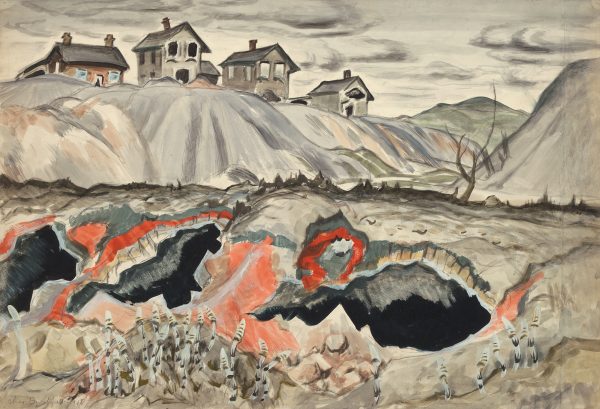
Abandoned Coke Ovens
Burchfield, Charles E.
1918, April 30
Artwork Information
-
Title:
Abandoned Coke Ovens
-
Artist:
Burchfield, Charles E.
-
Artist Bio:
American, 1893–1967
-
Date:
1918, April 30
-
Medium:
Watercolor, gouache, and graphite on paper
-
Dimensions:
18 x 26 1/2 in.
-
Credit Line:
Wichita Art Museum, Roland P. Murdock Collection
-
Object Number:
M154.58
-
Display:
Not Currently on Display
About the Artwork
Born in Ashtabula Harbor, Ohio, Charles Burchfield grew up in nearby Salem, and from 1912 to 1916 studied at the Cleveland School of Art. In 1921 he moved to suburban Buffalo, New York, where he lived for the rest of his life. Stylistically and thematically, Burchfield’s career went through three phases. Before 1918, he painted fantastical landscapes, drawn from childhood recollection and his imagination, visualizing the immaterial moods and sounds of nature. Rendered with calligraphic brushstrokes, the early paintings recorded Burchfield’s emotional responses to nature and memory. In 1918 Burchfield began painting from direct observation, realistically rendering the people and architecture of the local landscape. Less intimate than the earlier paintings, Burchfield’s middle period works were executed with a firmer, more controlled line. In 1943, Burchfield returned to his earlier concern with intensely emotional and highly personal images or nature, reworking ideas, and in some cases actual paintings, from his youth.
Painted near Burchfield’s hometown of Salem, Abandoned Coke Ovens dates from the beginning of the artist’s middle style. Burchfield recalls feeling “melancholy and depressed” during this transition all year as he awaited induction into the U.S. Army.1 A developing awareness of “the hardness of human lives” inspired Burchfield to paint “ ‘portraits’ of individual houses” that were intended as “social or economic comments” on the changing American landscape.2
In Abandoned Coke Ovens, thin paint application and quick, scratchy brushstrokes that allow pencil markings and white paper to show through—as, for example, in the clouds and hills—give the whole scene a dry and desiccated feeling. The doleful miners’ huts of Abandoned Coke Ovens seem anthropomorphic, with ashen complexions, wide gaping mouths, and sagging eyes underscored by heavy, black, down-turned lines. These dilapidated houses bear witness to the scorched earth and blood-red tailings in the foreground, and the “black cavities of abandoned coke-ovens [that] gleam like sinister eyes.”3 Burchfield recalled:
There were a number of small ‘ghost’ settlements around Salem at that time—most of them related to coal mining. As soon as the coal ran out the whole project was abandoned, the houses and ovens left to decay. At that time, such places had for me an almost ‘pre-historic’ feeling as though they had been abandoned centuries ago. I was fascinated with the oven in particular, it seemed to me to resemble the head of a gigantic buzzard. The peculiar plants in the foreground are… horse tails, the flowering phase which precedes the fern-like leaf that comes later (said by botanists to be the sole survivor of the prehistoric age of vegetation that produced coal).4 This botanical version is rooted in the detailed sketches the artist made in high school of the local wildflowers and trees, yet here Burchfield employs it with rueful intentions.
- Burchfield’s army service in the camouflage unit in South Carolina lasted from July 1918 until January 1919.
- Charles Burchfield, His Golden Year: A Retrospective Exhibition of Watercolors, Oils and Graphics (Tucson: University of Arizona Press, 1965), 23.
- Ibid.. 23.
- Burchfield, from an inscription on the back of the painting, 30 April 1918. Charles Burchfield, letter to Elizabeth S. Navas, 6 August 1958, registrar’s files, Wichita Art Museum.